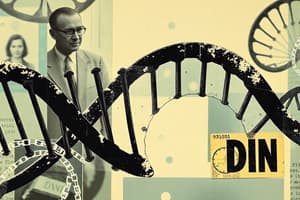Podcast
Questions and Answers
What is the structure of DNA often compared to?
What is the structure of DNA often compared to?
- A chain link fence
- A double helix or twisted ladder (correct)
- A spiral staircase
- A straight line
Adenine pairs with Cytosine in DNA.
Adenine pairs with Cytosine in DNA.
False (B)
What is the complementary DNA sequence for TAGGCATCTGC?
What is the complementary DNA sequence for TAGGCATCTGC?
ATCCGTAGACG
RNA is different than DNA because RNA is ___ stranded.
RNA is different than DNA because RNA is ___ stranded.
Match the following types of RNA with their functions:
Match the following types of RNA with their functions:
Which part of a nucleotide consists of deoxyribose?
Which part of a nucleotide consists of deoxyribose?
Proteins are made up of chains of nucleotides.
Proteins are made up of chains of nucleotides.
Describe how the sides of the DNA ladder are formed.
Describe how the sides of the DNA ladder are formed.
What is a mutation?
What is a mutation?
The three stages of the cell cycle are Interphase, Mitosis, and Meiosis.
The three stages of the cell cycle are Interphase, Mitosis, and Meiosis.
Name one risk factor that can cause mutations.
Name one risk factor that can cause mutations.
Mitosis turns 1 parent cell into _____ daughter cells.
Mitosis turns 1 parent cell into _____ daughter cells.
Match the stage of mitosis with its description:
Match the stage of mitosis with its description:
What is cytokinesis?
What is cytokinesis?
In plant cells, cytokinesis involves the formation of a cell membrane between the two nuclei.
In plant cells, cytokinesis involves the formation of a cell membrane between the two nuclei.
What occurs during interphase?
What occurs during interphase?
Flashcards
What is a mutation?
What is a mutation?
A permanent change in the DNA sequence of a gene or chromosome.
What can cause mutations?
What can cause mutations?
Incorrect DNA copying, exposure to radiation, smoking.
What is mitosis?
What is mitosis?
The process where a single parent cell divides into two identical daughter cells.
What happens during interphase?
What happens during interphase?
Signup and view all the flashcards
What is cytokinesis?
What is cytokinesis?
Signup and view all the flashcards
What are the main phases of the cell cycle?
What are the main phases of the cell cycle?
Signup and view all the flashcards
How is cytokinesis different in plant and animal cells?
How is cytokinesis different in plant and animal cells?
Signup and view all the flashcards
What are chromosomes?
What are chromosomes?
Signup and view all the flashcards
What does DNA stand for?
What does DNA stand for?
Signup and view all the flashcards
What is a nucleotide?
What is a nucleotide?
Signup and view all the flashcards
What are the four nitrogenous bases in DNA?
What are the four nitrogenous bases in DNA?
Signup and view all the flashcards
What is the shape of a DNA molecule?
What is the shape of a DNA molecule?
Signup and view all the flashcards
What makes up the sides of the DNA ladder?
What makes up the sides of the DNA ladder?
Signup and view all the flashcards
What makes up the rungs of the DNA ladder?
What makes up the rungs of the DNA ladder?
Signup and view all the flashcards
How do the nitrogenous bases pair up in DNA?
How do the nitrogenous bases pair up in DNA?
Signup and view all the flashcards
What is DNA replication?
What is DNA replication?
Signup and view all the flashcards
Study Notes
DNA and the Cell Cycle - Test Review
- DNA stands for Deoxyribonucleic Acid.
- The monomer that makes up DNA is a nucleotide.
- Nucleotides have three parts:
- Sugar (deoxyribose)
- Phosphate
- Nitrogenous base (A, T, C, G)
- There are four nitrogenous bases:
- Adenine (A)
- Thymine (T)
- Cytosine (C)
- Guanine (G)
- DNA molecules have a double helix or twisted ladder structure.
- The sides of the ladder are made of alternating sugar and phosphate molecules.
- The rungs of the ladder are made of nitrogenous bases paired together.
- Adenine pairs with Thymine (by two hydrogen bonds).
- Guanine pairs with Cytosine (by three hydrogen bonds).
- DNA replication involves the separation of the DNA strands and the pairing of new complementary bases.
- Mutations are permanent changes in the DNA sequence.
- Mutations can result from errors in DNA replication or environmental factors.
- DNA is copied in interphase
- Proteins are made from amino acids and are determined by instructions on genes located on DNA.
- RNA is ribonucleic acid and carries codes for making proteins from the nucleus to the cytoplasm.
- mRNA carries the message from the nucleus.
- rRNA is in ribosomes, which build proteins.
- tRNA carries amino acids.
- DNA is double stranded; RNA is single stranded.
- DNA sugar is deoxyribose; RNA sugar is ribose.
- DNA has Thymine; RNA has Uracil.
- A gene is a section of DNA on a chromosome that contains instructions to make a specific protein.
- Interphase is the period where the cell grows, carries out functions, and replicates its DNA.
- Mitosis is the process of nuclear division during the cell cycle.
- The stages of Mitosis are: Prophase, Metaphase, Anaphase, and Telophase
- Cytokinesis - division of cytoplasm
- Mitosis turns one parent cell into two daughter cells.
- Body cells undergo mitosis.
- Chromatin is DNA strands organized around proteins.
- Chromosomes are condensed chromatin.
- Chromatids are singular copies of DNA on chromosomes.
- Centromeres hold chromatids together, and attach to the spindle fibres.
- A human body cell has 46 chromosomes.
Studying That Suits You
Use AI to generate personalized quizzes and flashcards to suit your learning preferences.




